The Ultimate Guide for Choosing the Best E-commerce Platform
Table of Content
Diving into the world of e-commerce can be truly exciting for merchants, and nowadays, it also seems mandatory. To become a successful online merchant, many questions may arise, such as how to find the right distribution partner or the appropriate delivery service provider. However, these types of questions are typically raised in a later phase of the adventure, usually when thinking about gaining a competitive edge, expanding into international markets, enhancing the customer experience, and optimizing costs.
Therefore, one of the first steps is to find the right e-commerce platform to sell your products online. The one that fits your business model, current environment, and resources. It may also happen that you already have an online shop, but you are looking for a new solution for growth purposes or better performance. In this blog, we compiled an overview of the most popular and used e-commerce platforms, so you can easily identify which one fits your business model and resources the best.
Summary
- The state of the worldwide e-commerce market
- Open-source vs. SaaS: which one to choose?
- The top 5 most popular e-commerce platforms in Europe
- Shopify: the rising star of e-commerce platforms
- PrestaShop: the historic player in Western Europe
- Magento: e-commerce platform leader for large retailers
- WooCommerce (WordPress): scale-up your e-commerce store worldwide for free
- Wix Stores by Wix.com: making e-commerce website creation easy
- Special mentions
- From the right e-commerce platform to the perfect fulfillment partner

Overview
It is no secret that e-commerce has grown dramatically over the past years. Especially due to the worldwide pandemic situation during which most of the people had to shop online. According to eMarketer and Statista, retail e-commerce sales worldwide should reach $4.9 trillion by the end of 2021 (which is almost 4x more than it was 7 years ago). Even Nasdaq came out with its analysis, saying that by 2040, 95% of purchases would be done online.
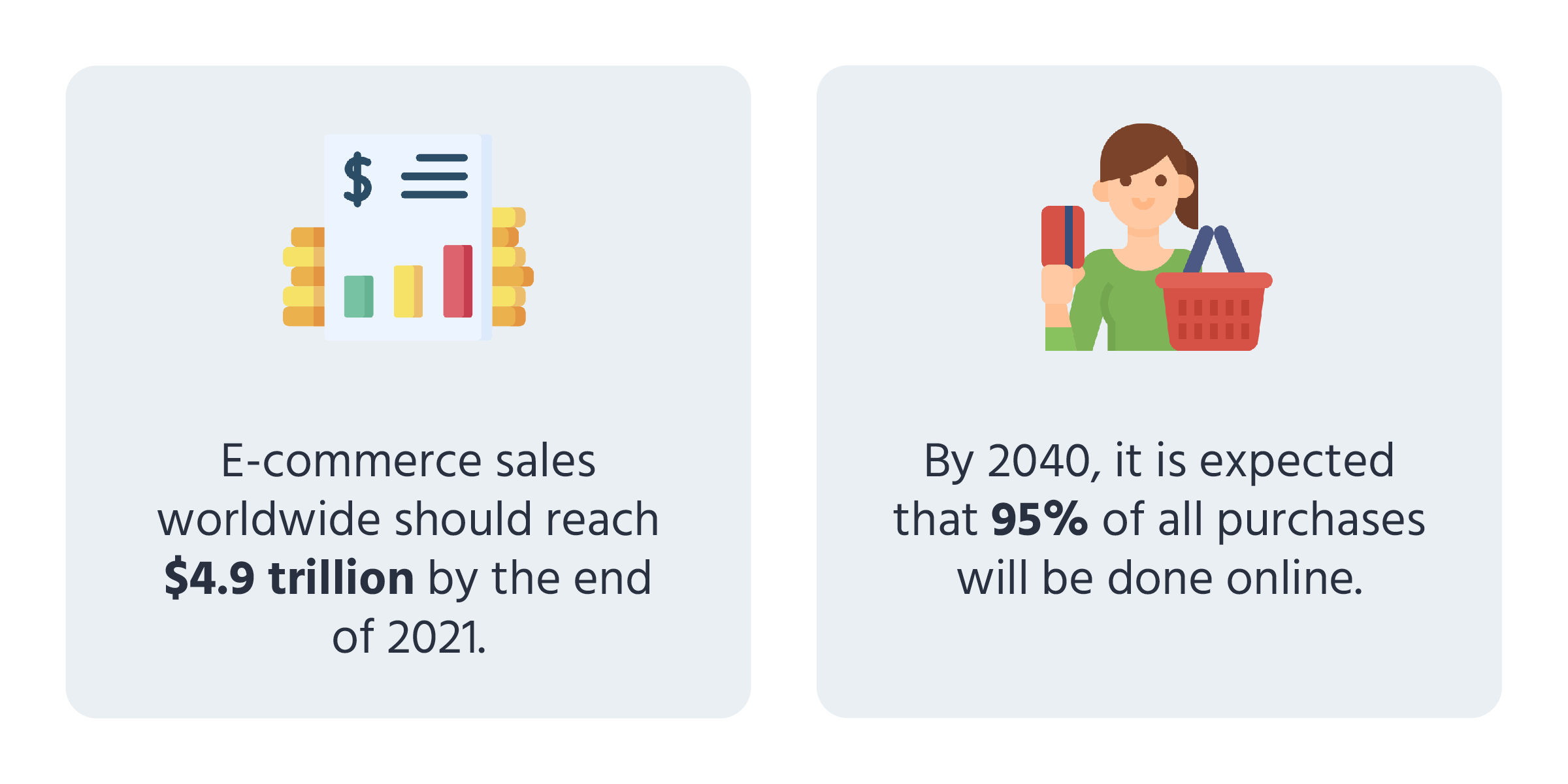
One of the key points highlighted by Shopify’s annual report on the e-commerce situation is the importance of scaling an omnichannel strategy for brands. Being able to advertise and sell your products on your different channels has become almost a must-do. This is also why using an e-commerce platform that integrates your social media channel for example, or your marketplaces can be a great solution for switching towards an omnichannel strategy.
From a European perspective, e-commerce has also boomed out over the last few years. The United Kingdom, Germany, and France are the leading countries here. The e-commerce market share for 2020 was estimated to be €717 billion (final results are still pending), which would mean an increase of 12,7% compared to the previous year. Howbeit, this is somewhat lower than the 14.2 percent increase in European e-commerce in 2019.
It’s important to note as well, the growth of cross-border e-commerce:
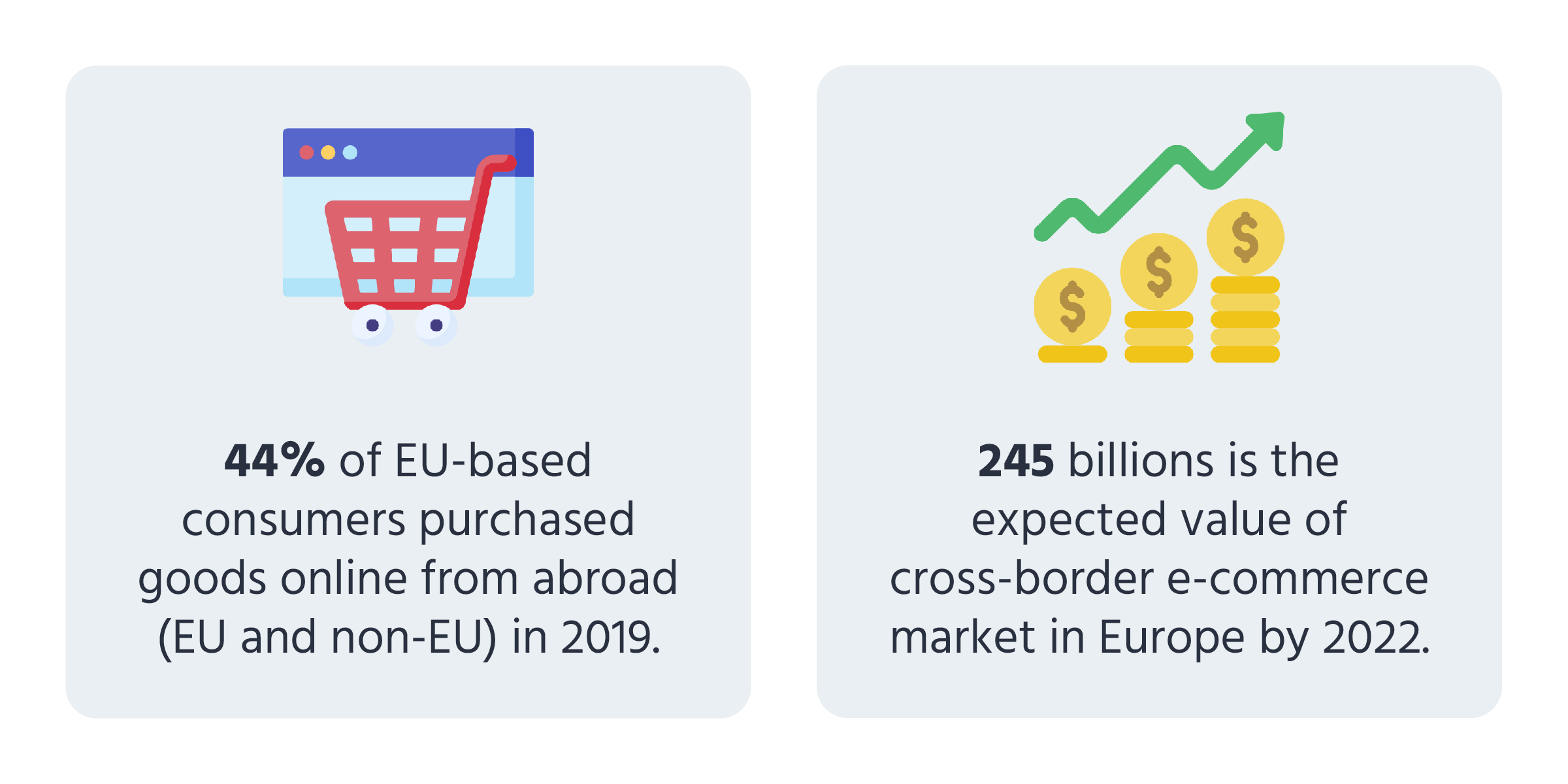
By the way, if you’d like to learn more about the French e-commerce market, check out our complete study:
Main tendencies in regard to e-commerce solutions
E-commerce giants such as Amazon and Alibaba have changed the game when it comes to online shopping. Features like free shipping options with optimized returns management, custom branding and sustainable packaging, expedited delivery, and even same-day delivery options are becoming industry standards set by e-commerce leviathans. In turn, independent online sellers have a hard time going toe-to-toe and competing with them on the market. However, having a performant, stable, and scalable e-commerce solution can make a world of difference.
Having said that, there are lots of e-commerce solutions available. Therefore, it is important to keep in mind that depending on the size of your business, your resources, your online traffic, and your products (or services), finding a perfect fit solution for you might be different from the “standard” go-to option.
Looking at the e-commerce platform global market, we can see that it’s very fragmented with historical players and some new, upcoming ones. In Eastern Europe, huge players like Magento and PrestaShop are still very popular (especially for medium and large companies) because of their operational capacities, security features, and basically their historical presence since it’s a mature market. However, we can see a switch in retailers’ choices, looking for more recent and fast-growing companies with interesting potential growth such as Shopify and Wix.com.
On a general level, the European market is much more fragmented. Shopify is leading the game in market share but not by far.
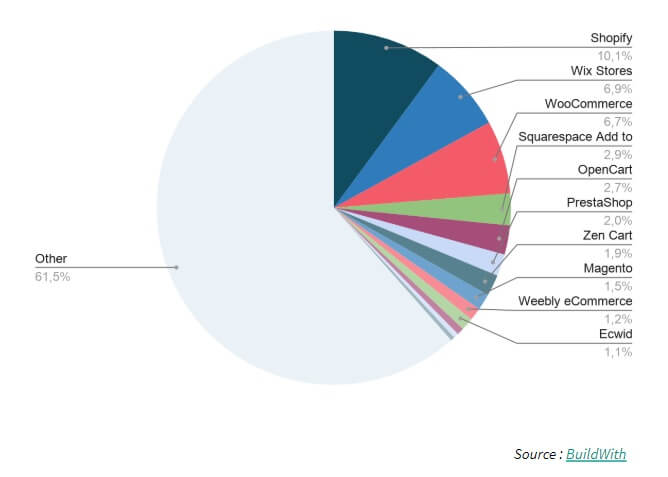
Moreover, if we segment the market by the “interest”, Shopify is taking the lead here. The prevalence of this Canadian subscription-based solution can be attributed to them being on the market for quite some time now and over the last several years they overcame many open-source challenges and passed countless milestones when developing their platform. However, when we look at things from a global perspective, some interesting geographical peculiarities emerge:
- English-speaking countries and Africa lean towards Shopify
- Europe, in general, is split between Magento, WooCommerce, and PrestaShop
- China and Russia have their own solution
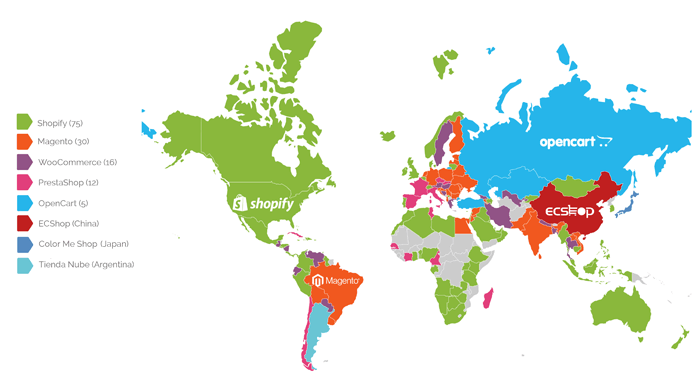
Main features to look for when selecting an e-commerce platform
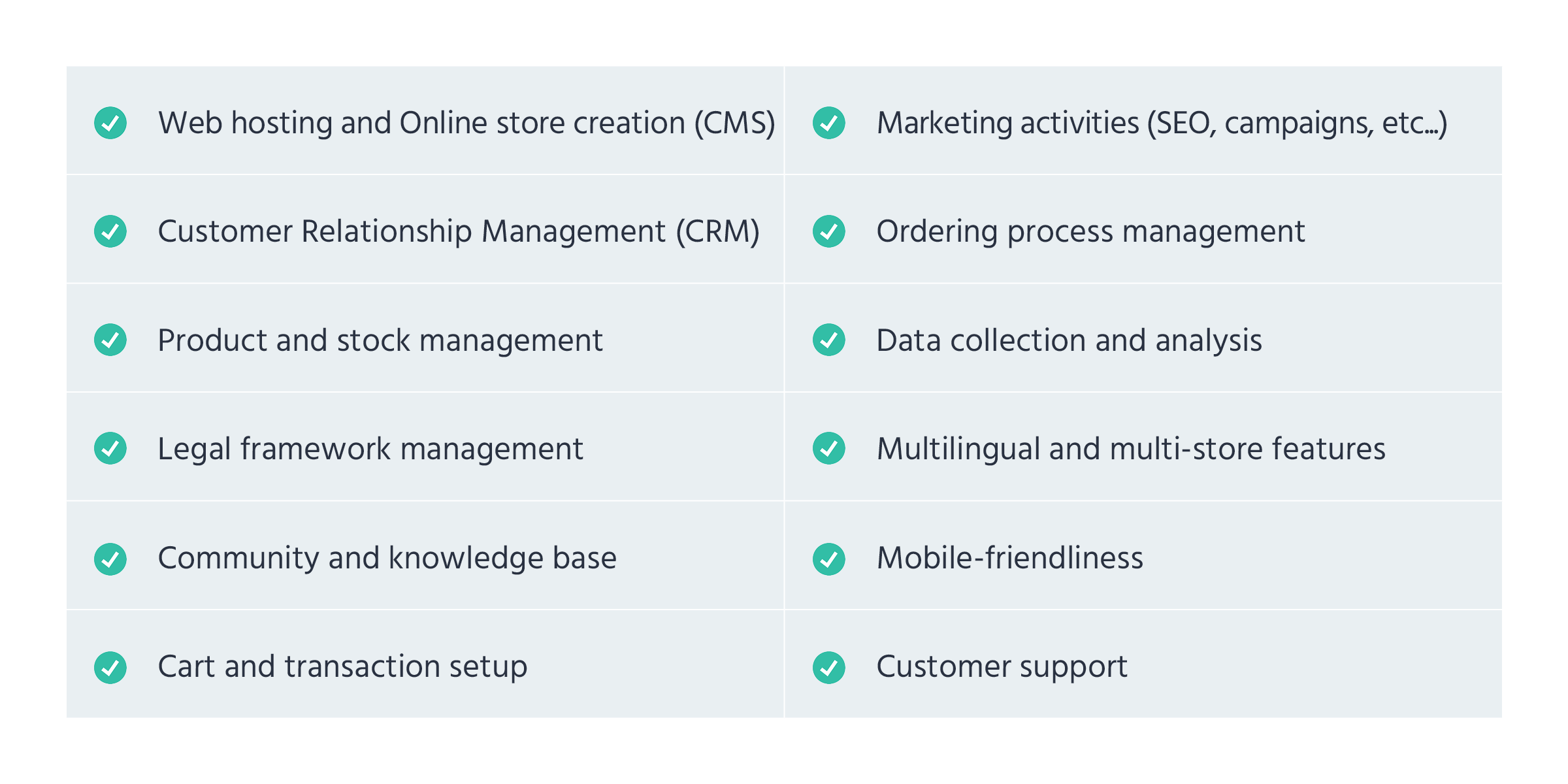
While there are many ways to compare e-commerce platforms, you should also consider which software architecture fits your business setup the best. Generally speaking, you have a split between two camps that will dictate how you interact and finance your platform – open source versus Software as a Service (SaaS). But before we jump to that, let’s first take a look at what are the main differences between the two.
Software as a Service (SaaS) Model
A SaaS is “a software licensing and delivery model in which software is licensed on a subscription basis and is centrally hosted”. Users subscribe to a cloud-based system allowing them to use a wide range of features and services.
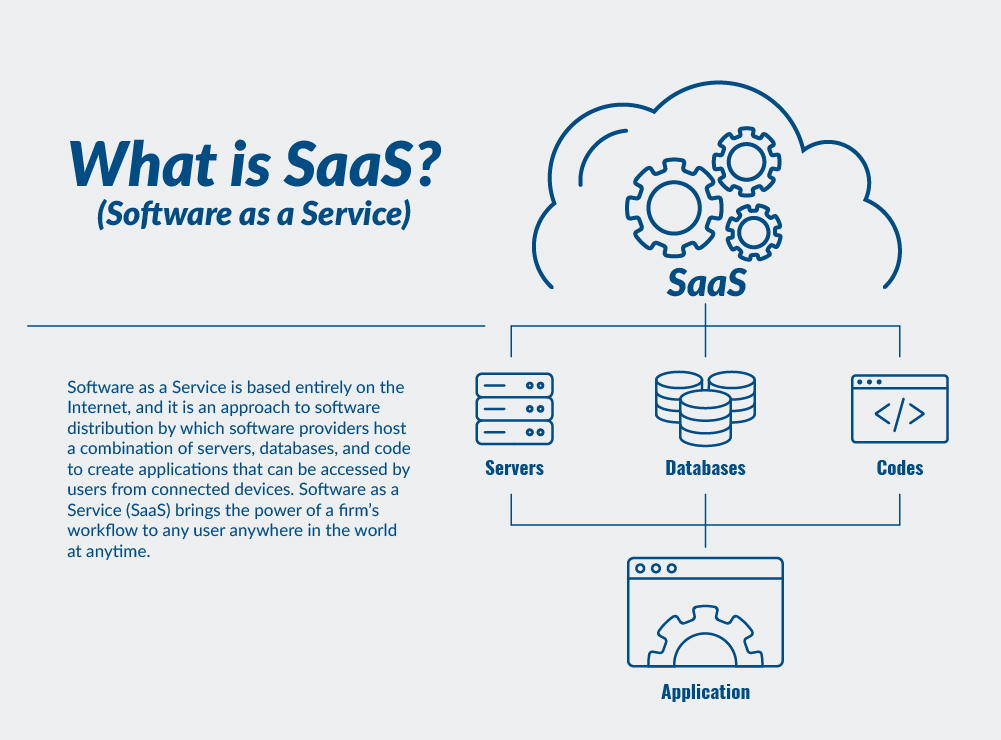 Source: atlantic.net
Source: atlantic.net
Examples of SaaS: SendinBlue, Talensoft, ContentSquare, AB Tasty, and Tilkee.
Open-source software
An open-source solution is free software accessible and usable by anyone. It is not only open access to the code, but it also means free distribution, modifications, and derived works and not restricted nor discriminated against anyone or any other solution.
Examples of open-source software: Apache, 7Zip, Audacity, Drupal, and Filezilla.
Which one to choose?
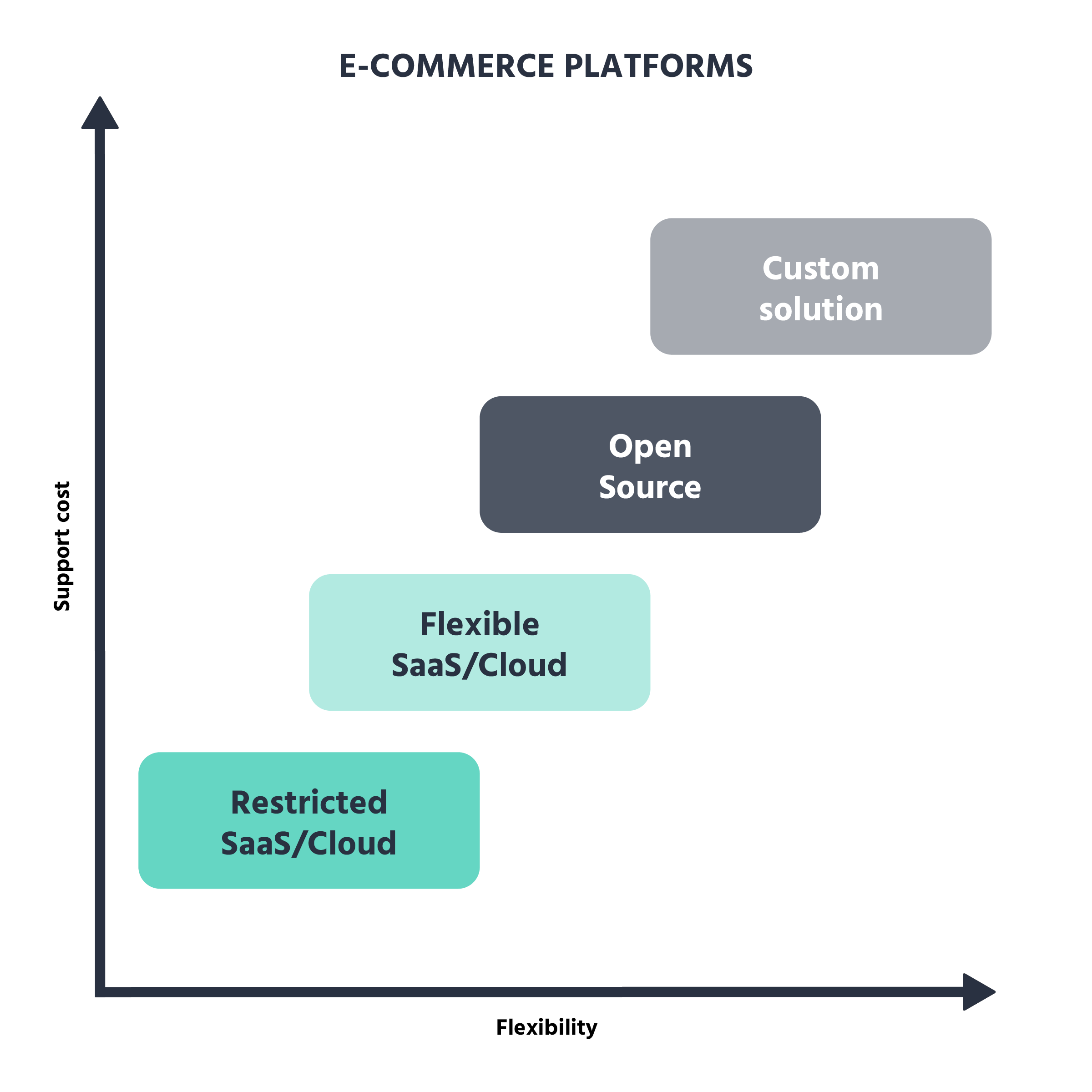
The graph above sums up the main differences between the two options. Open-source software is more flexible, because it is more customizable, and SaaS is less expensive in terms of global support costs due to the subscription model and the expertise of the provider.
So it’s hard to say whether to choose one or the other. It will depend on your business’s size, budget, and human resources, growth, etc. It’s also important to take into account the security issues, and your current technical environment. SaaS is becoming more and more popular because of its simplicity and ability to scale up.
For example, since 2017, there has been a switch of interest in the worldwide e-commerce industry. For example, by comparing the search trends between Shopify and PrestaShop, you can see that the Canadian SaaS solution is getting more interest. The same goes with the other open-source solutions:
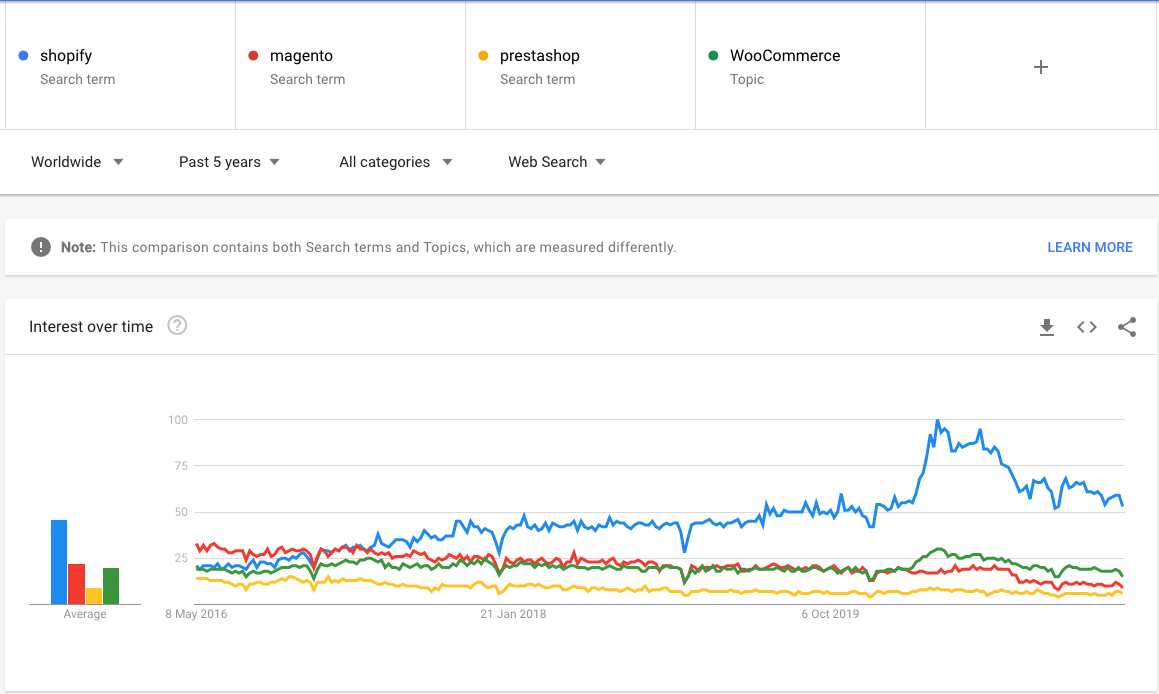 Source: Google Trends
Source: Google Trends
This is mainly because of the user-friendliness and the ease to launch an online shop with a SaaS solution.
Disclaimer: It goes by without saying, but this list has, by no means, been made to rank any of these solutions. The main purpose of this list is to provide an informative overview of different e-commerce solutions that are most widely used among online retailers in Europe. Therefore, we advise you to compare different solutions yourself and decide which e-commerce platform fits your needs best.

Founded in Ottawa, Canada in 2006, Shopify’s story is both surprising and game-changing in the e-commerce environment. Founders Tobias Lütke and Scott Lake had the original idea to open up an online store for snowboarding. But because the market wasn’t mature enough and, at that time, e-commerce wasn’t as developed as it is now, they decided to go with a different idea.
They created and launched their e-commerce product. In 15 years, Shopify became one of the most powerful and used commerce platforms in the world, especially in English-speaking countries. It’s also one of the most important companies in Canada’s economy.
Today, Shopify intends to become the world’s leader as an all-around e-commerce solution for retailers. With its proprietary shop system, payment solution, fulfillment network, and customer success management services, this Canadian rising star is creating a powerful e-commerce environment for online retailers that are looking for an all-in-one business solution. Whilst at the beginning, the solution was more oriented to small businesses, in 2014, they launched Shopify Plus: an e-commerce platform specifically designed for fast-growing and large online businesses.
The current situation and data for Shopify (2020-2021):
- Almost 1.6 million websites using Shopify in 175 countries (according to Builtwith)
- Shopify claimed a global revenue of $2.93 billion in 2020
- Fast-growing company and environment with multiple integrations and partnerships with other internet giants: Facebook, TikTok, YouTube, Hubspot, Pinterest, etc.
Pricing model
Shopify pricing model is a monthly subscription-based model with commissions on sales based on turnover.
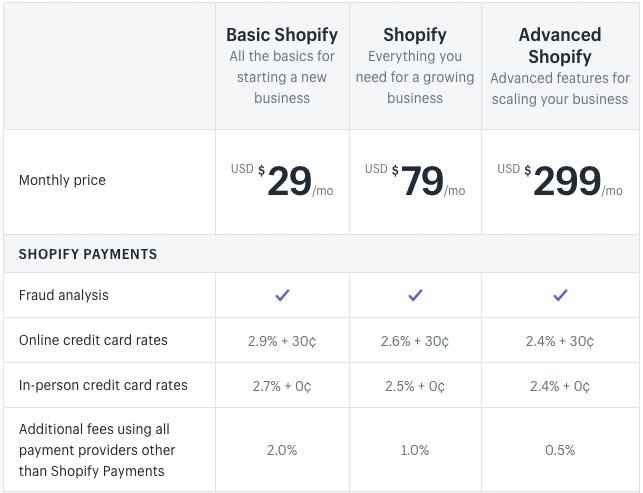
Advantages
- Shopify is customer-friendly and quite easy to use. The platform enables users to create and implement an online shop in a few clicks. In addition, Shopify Community connects more than 800.000 online merchants in a huge knowledge base and FAQ section. And Shopify Partner Academy will accompany you to become an e-commerce expert.
- The e-commerce solution works as a shop system and as a CMS. You can manage your web hosting settings and SEO performances.
- There are all sorts of plug-ins and add-ons (Shopify Apps) to customize your online store and make the customer experience better.
Disadvantages
- The pricing and transaction-based model, depending on the formula chosen, can be an important factor, especially for small online stores and startups since there is no free subscription plan.
- Since Shopify is a SaaS solution, the possibilities of fully customizing your e-commerce environment are quite complex and restricted.
- The e-commerce market is quite mature, so the confidence and knowledge about this solution still need to be improved, especially for medium and large online businesses.
In which case you should opt for Shopify?
Given its main features and services, the main purpose of Shopify is to enable anyone to kickstart their e-commerce business and create its first online shop, as seamlessly as possible. Therefore, this e-commerce platform aims to cater to small and medium-sized businesses and e-merchant beginners. So, if you want to become an e-merchant or scale up your business, this might be a good solution for you. However, as already mentioned, Shopify launched a few years ago Shopify Plus which is specifically dedicated to large businesses and retailers. You also need to take into account that, as a North American company, there might be some cultural differences and approaches regarding the e-commerce environment, as well as a lack of available information for businesses based outside of North America.

Born in France in 2007, PrestaShop is a great example of a made-in-France success story. It started in one of the most important tech schools in the country (Epitech). What was a student project at the beginning, grew quite fast and became the most used e-commerce platform in France (16,9% of market share in 2020, 6% worldwide).
The main reason for its success comes from its structure and how it is built. Like WooCommerce and Magento (we will get back to these two later), PrestaShop is an open-source solution built by specialists but also e-commerce experts, and merchants themselves. For instance, you can find the source code and all updates on GitHub.
The French e-commerce platform has become in a decade the leader in France, allowing more than 50,000 companies to sell their products online.
Current situation and data for PrestaShop:
- As mentioned above, PrestaShop is leading the e-commerce market as the most used and important e-commerce platform in France (28% of usage distribution).
- 300,000 websites are using the French solution worldwide, which makes it the leader in Europe and Latin America.
- End of 2019, PrestaShop’s CEO stated that there’s one online store created every four minutes, and the turnover of all e-merchants and retailers is estimated at €15 billion.
Pricing model
Like Stevie Wonder would say, “I’m free!”; and the same goes for PrestaShop. Creating your online store is free of charge, however, there are some parallel costs. For example, if you need to buy a web domain, then there can be some technical and development needs for more customization. In a nutshell, most entry-level things are free, whereas additional add-ons and plugins, also called modules, that enable you to integrate new features to your e-commerce store, often come with a price tag, and that is the core of PrestaShop’s pricing model.
Advantages
- Creating your online store with PrestaShop is completely free, making it interesting to launch your project and scale up while minimizing your costs.
- PrestaShop is still a human-sized company, even though they are available in many countries now. By choosing this provider, you are covered and supported by a small team of e-commerce and tech experts.
- Large community users, fully customizable, and pretty intuitive, all of this makes PrestaShop quite easy to use for anyone.
Disadvantages
- Many features (basics and more advanced ones) are not free, and some are a bit expensive. There are more than 4,000 plug-ins, add-ons, modules, themes, etc. available on their Marketplace. For example, you can opt for Amazon Marketplace integration if you pay €279.99 for it, or can go for an SEO starter pack bundle, priced at €246,99.
- Scaling up while fully customizing your PrestaShop online shop can become an issue technically in the long term, especially if you make structural changes or updates.
- Setting up your online shop (buying a domain, creating, implementation, etc) might be difficult depending on your business model. As well as resolving technical issues (such as loading speed) and getting customer support’s help.
In which case you should opt for PrestaShop?
As well as Shopify, PrestaShop was at first intended for SMEs. But since the French company followed and led the growth of e-commerce in France, many big companies are still using the solution (e.g. Danone). That’s why it’s an all-around player.
Since it’s a free solution, it is probably a good solution (whether short-term or long-term) to kickstart your project and dive into the retail world. One important note however is the technical side. If you are not, or you do not have the technical capacities available in the team to build up and manage your PrestaShop store, this might become quite costly in the long run: customer support (€399 for 6 hours of support), external developers and such can drive up your costs quickly.

Magento’s adventure started in 2007 in California. It is also an open-source solution, but a bit more complex and complete than the other platforms on the market. For example, it allows merchants and retailers to sell a large number of products and SKUs. But also, to create different brand stores under one bigger entity.
The growth and behind-the-scenes story of Magento was also quite a long way to success. For several years, the company has been owned, funded, and “controlled” by different investors and private big companies such as Varien Inc., eBay, Permira. Currently, Magento has entered into the US giant Adobe’s portfolio, which is a great competitive advantage and growth venture to create an omnichannel web environment.
Today, the American company is considered one of the most performing and used e-commerce solutions in the world for medium and large companies. Moreover, there have been some significant updates and changes within their business model, namely by launching Magento 2, becoming part of Adobe, and creating an omnichannel cloud-based environment, also known as Adobe Commerce.
Current situation and data for Magento:
- According to Builtwith, more than 200,000 live websites are using Magento (6,000+ in France), and more than 740,000 created historically.
- The cumulated annual turnover for Magento online stores is $155 billion worldwide.
- 1.5% of e-commerce stores were created via Magento in 2020 and its market share is 3.4% (La Fabrique du Net). There is a slight decrease in interest and importance overall for this solution.
Pricing model
There are 3 different models right now available depending on the size of your company and financial resources:
- Free open-source solution
- The “Small Business” solution which costs around €2,000 per year
- The “Mid and Enterprise” Solution which is around €15,000 per year
Advantages
- Magento offers a wide range of features and functionalities: online selling, marketing (promotion, advanced SEO), ordering and payment solutions, multistore creation and management, etc. In addition to the connection with Adobe Cloud features
- High-level customization possibilities: there are more than 4,000 plug-ins and extensions (free or not) available, and the Adobe Cloud service enables powerful design and creativity differentiation.
- The Adobe environment is becoming more and more popular and powerful. The community gathered more than 350,000 users and contributors. There are frequent updates and new features.
Disadvantages
- One of the main obstacles with Magento is the price. As it’s more oriented for medium and large companies that need a complete and huge infrastructure, this is probably a great and long-term investment, but riskier for startups and SMEs.
- As previously mentioned, customization possibilities are extensive. However, most of the time, they are complex and need expert knowledge or external assistance (which can be a costly endeavor in the long run).
- Magento has the reputation of being a large and complex solution, which is hard to customize on a technical level, and that can’t fit every business model.
In which case you should opt for Magento?
As mentioned, the goal of Magento now being part of the Adobe Commerce Cloud is to create a fully integrated e-commerce environment. To put it in other words, if you want to benefit from all the features and create the best customer experience possible, it might demand quite some resources. This is probably why Magento makes more sense if you run a medium or large e-commerce company already.
However, the American giant intends to be more open to any business size with different pricing models and build a large community of users.


Launched in 2011, WooCommerce is an open-source e-commerce plug-in supported by WordPress. It is very simple to use, it is customizable and is a freebase solution. Something that was “just” a theme initially became one of the most popular and used e-commerce solutions in the world.
WooCommerce is not an e-commerce platform or an e-commerce website builder if we look closely and want to be precise. It is an extension add-on to your WordPress site.
Current situation and data for Magento:
- 82+ million downloads (all-time and worldwide). Almost 94% of all WordPress e-commerce websites use WooCommerce.
- Currently, there are 3,8 million e-commerce websites (January 2021) using the open-source solution, which makes the market share of WooCommerce worth 40% worldwide.
- 29% of the top 1 million sites using e-commerce technologies is WooCommerce.
Pricing model
Similar to the other open-source solutions, WooCommerce is free. You’ll just need a website domain. In addition, there are additional features, themes, and plug-ins that you can purchase on the WordPress marketplace.
Advantages
- A free and open-source solution accessible by anyone. As it’s operating on WordPress, you can have access to a large range of add-ons to fully customize your website.
- Hundreds of extensions and more than 1,000 downloadable plug-ins to customize your online shop. Besides, WooCommerce is one of the biggest theme providers with 2,000+ themes.
- WordPress is well known to be easy to use for anyone with a large community of users who can help you with setting up your online store, scaling up, debugging, etc.
Disadvantages
- If you want your website to be fully customizable with very specific features (e.g. conversion optimization, cross-selling, etc.) you might need to pay. There are lots of paid extensions, sometimes expensive, that could become essential for your e-commerce growth.
- As an open-source and freebase software, WordPress is often updated which can temporarily affect either the extensions you are using and, on a general level, the efficiency of your online shop.
- Depending on your setup, the website’s loading time can impact and reduce the online customer experience.
- You can find some WooCommerce Subscriptions alternatives here.
In which case you should opt for WooCommerce?
Well here the answer is quite simple: to use WooCommerce, you need a WordPress domain. So if you already have a “showcase”/branding website on WordPress, using WooCommerce might be highly recommended or at least a good idea. Since half of the websites worldwide use WordPress as CMS, it shows that this solution is very popular and all-around.
However, as we say in the disadvantages, the more your business will grow, the more difficult it can be to manage the website and a wider range of products and activities.

Wix.com was founded in 2006 in Israel. Just like WordPress, it’s a software company that provides cloud-based web services such as website creation and CMS, app development, content creation, and an e-commerce platform called Wix Stores.
Wix is a good example of a fast-growing online company. Just after 4 years of existence (2010), Wix already had more than 3.5 million users. One year later, they already had over 8.5 million users and they have gained a whopping $61 million of investment capital to further expand their business. Today it’s one of the world’s leaders in web services.
But what makes this Israeli company so successful? One of the answers is probably its modus operandi. Indeed, user-friendliness and accessibility are the main keywords for people at Wix. Wix.com allows users to create HTML5 and mobile websites with a “simple” drag-and-drop functionality. This internet giant has literally made website creation accessible to almost everyone.
Current situation and data for Wix Stores:
- Worldwide, the company claims 200+ million users now, in 190 different countries, which makes it the second-largest CMS and web services provider after WordPress.
- Regarding Wix Stores, according to Builtwith, there are almost 1.5 million live e-commerce sites, and 4+ million historically.
- In terms of market share, Wix Stores comes second worldwide (6.9%), right in between Shopify and WooCommerce.
Pricing model
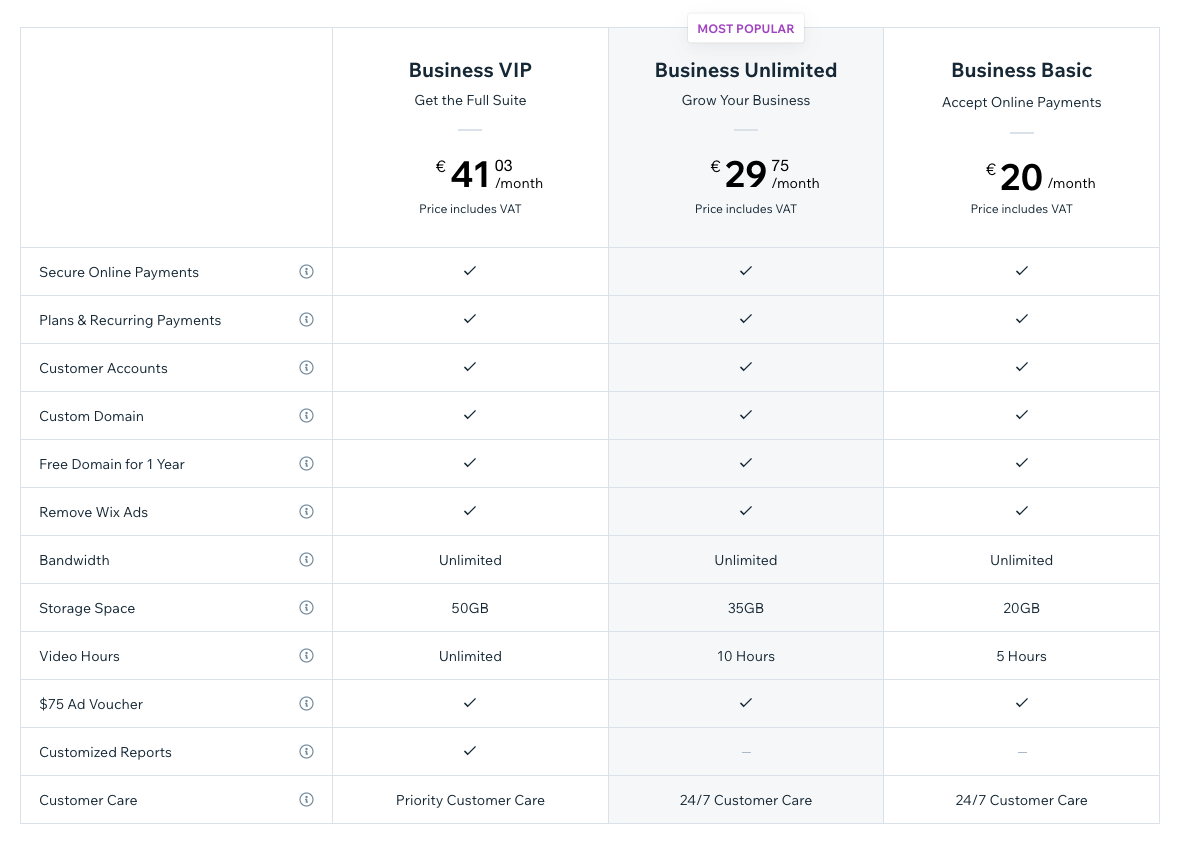
Wix.com is a freemium business model. It means that you can create a website for free, but you need to pay for additional features. Wix Stores is one of these features. As you can see above, 3 different premium subscription types exist, depending on your business size, types of products, needed features, integrations, etc.
Advantages
- As mentioned before, one of the main assets of Wix is the drag-and-drop functionality. Without any coding skills, you can easily create and start your online store within a few hours. In addition, the customer support team is available in many languages at any time.
- Creating a Wix Store allows you to benefit from the whole Wix creative environment with frequent updates and add-ons (content creation, customization tools, AI tools, etc.).
- Benefit as well of a large community of designers and developers that provide (sometimes for free) new templates, plug-ins, etc.
Disadvantages
- The drag-and-drop functionality has its limits. The customization possibilities are quite low and restricted. In addition, once you have chosen an initial template, it becomes very difficult to change it in case you want to rebuild or freshen up your online shop.
- As well as customization possibilities being quite limited, Wix Stores doesn’t provide many additional important features like customer management, elaborate marketing activities, legal framework, etc.
- As a result, and as you may have noticed, Wix Stores targets mainly SMEs and startups. Once you have a wide range of products, or you develop your activities in a new foreign market, you might start to take a look at the competition.
In which case you should opt for Wix Stores?
Like WooCommerce, Wix Stores needs a Wix.com domain to work. In addition, we have seen through the pricing model and how it works (drag and drop), this e-commerce platform may be more appropriate for e-commerce startups and SMEs.
Special mentions
As mentioned before, the market is quite fragmented. There are lots of other e-commerce platforms available and used by retailers and e-merchants:
- Shopware: learn more here
- Plentymarkets: learn more here
- OpenCart
- Zen Cart and OsCommerce
- Salesforce Commerce Cloud
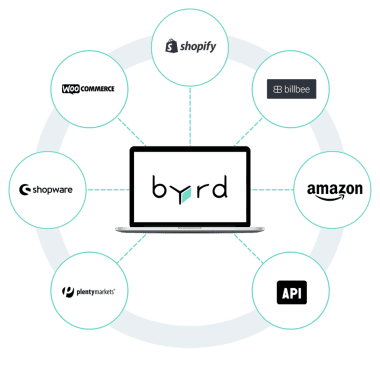
From the right e-commerce platform to the perfect fulfillment partner
Selecting your e-commerce platform is definitely important for your business development and success. Having optimized logistics, seamless returns management solutions, free and expedited shipping options, and enhanced customer experience with personalized branding will give you the much-needed competitive advantage over your competitors. However, these advantages can be achieved mainly through having a scalable and ready-made fulfillment solution. Therefore, the order fulfillment process that happens from the moment when your customer purchases your product is as important as having the right e-commerce platform.
Order processing, storage, delivery, return management, etc. This is what we call e-commerce fulfillment. Here you have two choices:
- In-house fulfillment
- Outsourced fulfillment with an experimented partner
Should you opt for the latter, to outsource your order fulfillment to a 3PL and fulfillment partner (like byrd), you should first make sure they can integrate with your e-commerce platform. Having seamless integration available for your e-commerce platform and fulfillment software is paramount, as it gives you the benefit of an interconnected and cloud-based environment with live data transfer and harmonized order management.
Last but not least, when opting for a 3PL partner, you should search for a solution that will enable you to grow internationally and scale up your business with ease. Usually, that means having decentralized inventory options available in different countries and having optimized reverse logistics available, which should be on the top of your “must-have” list.
Check out our Europe-wide fulfillment solution or check our available e-commerce integrations: FBM, Billbee, Plentymarkets, Shopify, Shopware, and WooCommerce. Let us know how we can help you grow your e-commerce business.

